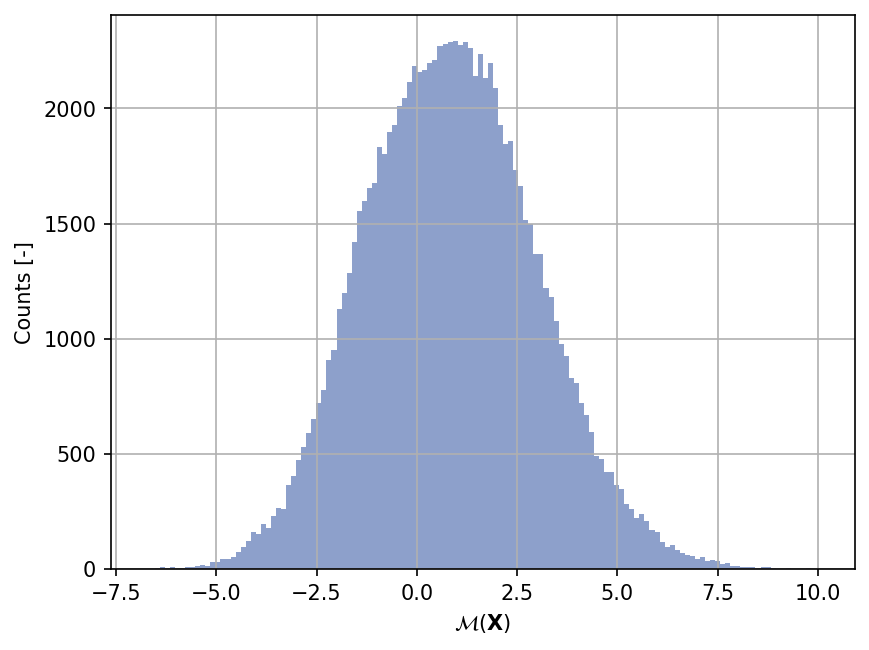Welch et al. (1992) Function
Contents
Welch et al. (1992) Function#
import numpy as np
import matplotlib.pyplot as plt
import uqtestfuns as uqtf
The Welch et al. (1992) test function (or the Welch1992 function for short)
is a 20-dimensional scalar-valued function.
The function features some strong non-linearities as well as some
pair interaction effects. Furthermore, a couple of two input variables
are set to be inert.
The function was introduced in Welch et al. (1992) [WBS+92] as a test function for metamodeling and sensitivity analysis purposes. The function is also suitable for testing multi-dimensional integration algorithms.
Test function instance#
To create a default instance of the test function:
my_testfun = uqtf.Welch1992()
Check if it has been correctly instantiated:
print(my_testfun)
Name : Welch1992
Spatial dimension : 20
Description : 20-Dimensional function from Welch et al. (1992)
Description#
The Welch1992 function is defined as follows1:
where \(\boldsymbol{x} = \{ x_1, \ldots, x_{20} \}\) is the 20-dimensional vector of input variables further defined below. Notice that the input variables \(x_8\) and \(x_{16}\) are inert and therefore, missing from the expression.
Probabilistic input#
Based on [WBS+92], the test function is defined on the 20-dimensional input space \([-0.5, 0.5]^{20}\). This input can be modeled using 20 independent uniform random variables shown in the table below.
my_testfun.prob_input
Name: Welch1992
Spatial Dimension: 20
Description: Input specification for the test function from Welch et al. (1992)
Marginals:
| No. | Name | Distribution | Parameters | Description |
|---|---|---|---|---|
| 1 | x1 | uniform | [-0.5 0.5] | None |
| 2 | x2 | uniform | [-0.5 0.5] | None |
| 3 | x3 | uniform | [-0.5 0.5] | None |
| 4 | x4 | uniform | [-0.5 0.5] | None |
| 5 | x5 | uniform | [-0.5 0.5] | None |
| 6 | x6 | uniform | [-0.5 0.5] | None |
| 7 | x7 | uniform | [-0.5 0.5] | None |
| 8 | x8 | uniform | [-0.5 0.5] | None |
| 9 | x9 | uniform | [-0.5 0.5] | None |
| 10 | x10 | uniform | [-0.5 0.5] | None |
| 11 | x11 | uniform | [-0.5 0.5] | None |
| 12 | x12 | uniform | [-0.5 0.5] | None |
| 13 | x13 | uniform | [-0.5 0.5] | None |
| 14 | x14 | uniform | [-0.5 0.5] | None |
| 15 | x15 | uniform | [-0.5 0.5] | None |
| 16 | x16 | uniform | [-0.5 0.5] | None |
| 17 | x17 | uniform | [-0.5 0.5] | None |
| 18 | x18 | uniform | [-0.5 0.5] | None |
| 19 | x19 | uniform | [-0.5 0.5] | None |
| 20 | x20 | uniform | [-0.5 0.5] | None |
Copulas: None
Reference Results#
This section provides several reference results of typical analyses involving the test function.
Sample histogram#
Shown below is the histogram of the output based on \(100'000\) random points:
np.random.seed(42)
xx_test = my_testfun.prob_input.get_sample(100000)
yy_test = my_testfun(xx_test)
plt.hist(yy_test, bins="auto", color="#8da0cb");
plt.grid();
plt.ylabel("Counts [-]");
plt.xlabel("$\mathcal{M}(\mathbf{X})$");
plt.gcf().set_dpi(150);

Definite integration#
The integral value of the test function over the domain \([-0.5, 0.5]^{20}\) is analytical:
Moments estimation#
The moments of the test function may be derived analytically; the first two (i.e., the expected value and the variance) are given below.
Expected value#
Due to the fact that the function domain is a hypercube and the input variables are uniformly distributed, the expected value of the function is the same as the integral value over the domain:
Variance#
The analytical value (albeit inexact) for the variance is given as follows:
References#
- WBS+92(1,2,3)
William J. Welch, Robert. J. Buck, Jerome Sacks, Henry P. Wynn, Toby J. Mitchell, and Max D. Morris. Screening, predicting, and computer experiments. Technometrics, 34(1):15, 1992. doi:10.2307/1269548.

